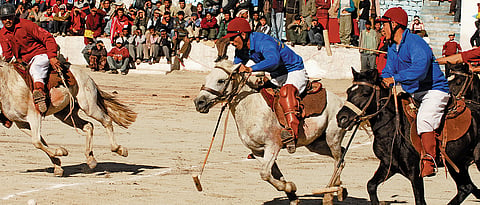
- Destinations
- Experiences
- Stay
- What's new
- Editor’s Picks
- Responsible Tourism
- CampaignsCampaigns
- Subscribe

If you have travellers luck, you might see a polo match on your Ladakh trip. But there is a flip side too Its unlikely that you will ever enjoy polo anywhere else again. Hear this description by David Fraser, a Scottish traveller who saw a match in Leh in 1906. The rather unusual venue was the main bazaar street. The game was composed of all the sportsmen who like to join, with the onlookers settled in the doorways, balconies, and upon the roofs of the houses.
Everybody holds their breath while the ball is tossed up and is dropping to meet the unerring aim of the club that sends it flying. Helter-skelter follow the players Out darts the Compounder The Post Office charges The Yarkandi merchant saves The Zemindar from up the road gains the ball The Serai Manager takes it from him, and the Tehsildar strikes a goal with a blow from his club that sounds like the crack of doom Phew Tis both hot and fast, is polo at Leh.
It also requires certain skills your everyday international polo playerand his polo ponywould be hard pushed to come up with. In Ladakh, the players take for granted the extraordinary degree of hand-eye coordination necessary to start the game in the way Fraser describes the horse at full gallop controlled with the left hand, while the right holds both ball and mallet the ball tossed in the air and the mallet swung so as to hit it, with unerring accuracy, before it reaches the ground. Ask your average international player to do that and see what he makes of it. Ladakhs polo ponies too, hardy beasts from Zanskar, would disdain the five-minute chukker of their international counterparts. In Ladakh, if you please, they keep going all out for two 25-minute halves without needing any breaks.
This is polo as discovered by the British around 1860. Their version of the game became more refined, and elitist. In Leh, it continues to be more egalitarian though it is no longer played up and down the bazaar. It now enjoys a spectacular setting on the polo ground at the top of the town, in the shadow of the mountains and of the 17th-century palace. This is where youll most likely see a match on your trip.
